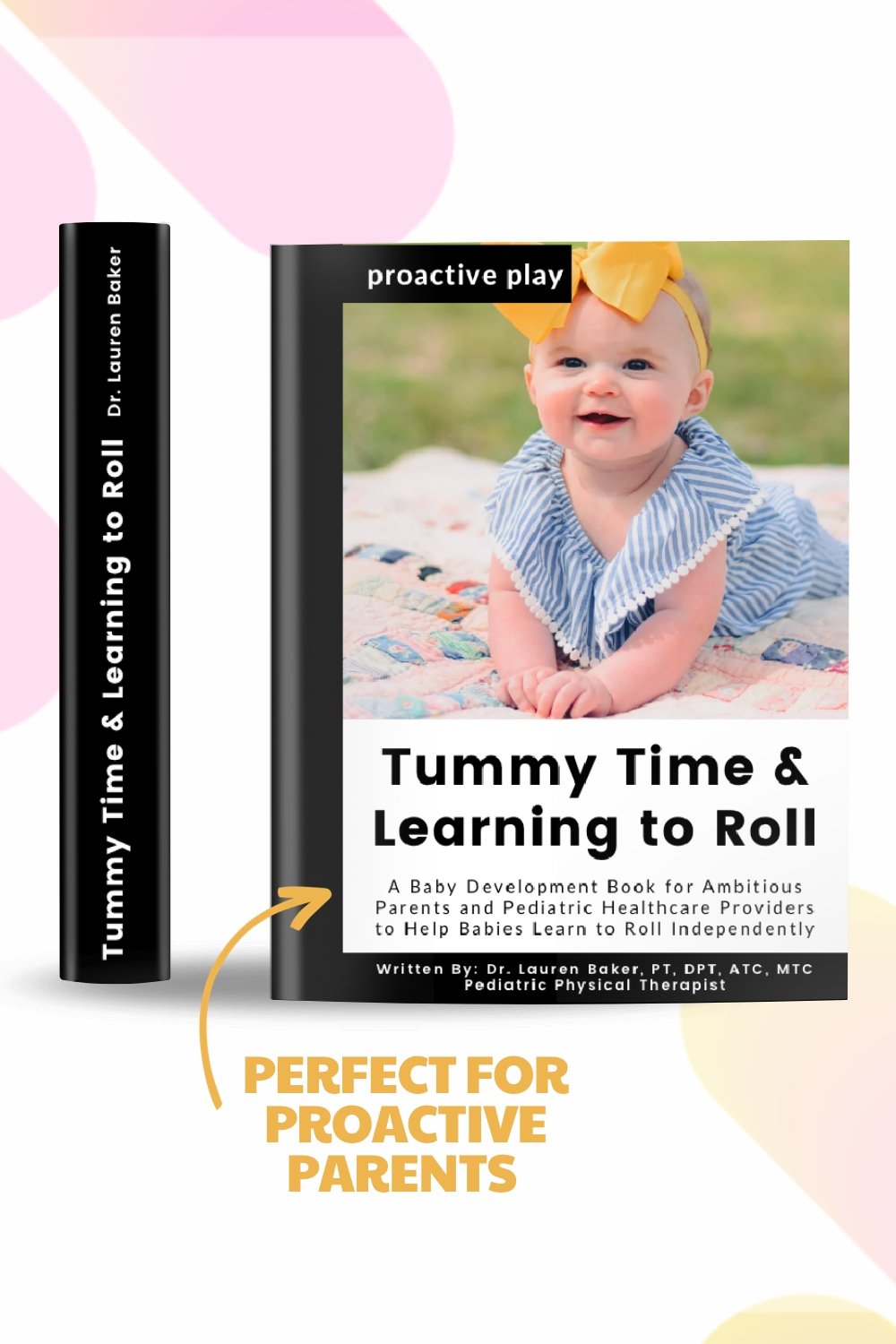Prevent Avoidable Motor Delays: How To Test Your Baby's Trunk Mobility
this blog contains affiliate links
Hello! I'm Dr. Lauren Baker, a pediatric physical therapist. Today, I'm thrilled to share insights on one of the most crucial aspects of your baby's development - trunk rotation. This aspect of movement plays a pivotal role in milestones like rolling, sitting, crawling, and walking and it’s one of the least known aspects of movement and baby development in the parent world. Today, we are going to change that!
Why Is Upper Trunk Rotation Important?
Upper trunk rotation is essential for your baby's overall mobility. It's the foundation for many activities, including the ability to roll over, going from lying on the ground to sitting up, going from sitting to crawling, and it is even needed when we walk.
When we talk about trunk rotation, we're referring to the upper half of the body moving independently from the lower half, this of sitting in a chair and twisting your shoulders to look behind you (your upper half is moving but your lower half isn’t). This movement is crucial for maintaining our position against gravity, for getting in and out of positions, and for combining motions which we need for complex movements like walking and crawling.
Assessing Trunk Rotation in Babies
To ensure your baby is developing symmetrically and has mobility equally side to side, it's vital to assess their upper trunk rotation. When doing this, we're looking for equal movement on both sides. A limitation on one side can affect how your baby moves, potentially leading to preferences that might impact their development down the line.
Tightness in one direction can also lead to avoidance of movement in that direction, which is often why you see babies choose to only roll to one side (if we know what is limiting them, we can help them fix it! And then they can roll equally to both sides).
Baby Mobility Exercises: Enhancing Trunk Rotation
To encourage healthy trunk rotation in your baby, first try to see if your baby’s upper trunk can go equally in both directions. While they are sitting between your legs, gently move their upper body from forward to the right, stopping when you feel resistance (this is as far as you should go) and then forward to the left, again stopping when you feel resistance.
Watch the video below start to finish for the most comprehensive explanation and demonstration or click on the hyperlink to go directly to the exercise to watch in order to make sure you do it correctly!
TIMESTAMPS:
1:27 why upper trunk rotation and baby trunk rotation is important
4:52 straddle baby trunk rotation assessment
5:17 ring sit baby trunk rotation assessment
6:23 baby between parent's legs baby trunk rotation assessment
TOY IDEAS:
Trunk Weakness in Babies: Spotting and Addressing It
If you notice that your baby struggles with trunk rotation (typically you will feel resistance or they will express displeasure in that direction) or they seem to favor one side, it might indicate trunk weakness or tightness. Weakness and tightness are often companions, as a tight muscle is also a weak muscle, so sometimes when we increase the range and resolve the tightness, we then have to strengthen those muscles.
However, if you do not notice your baby has tightness when doing the upper trunk screen, but they do still show a preference, they could have weakness in the muscles that are needed to go in the direction they are avoiding. Weakness can be associated with tightness or it can be the only thing affecting the child.
It's important to be aware if your baby is experiencing trunk weakness. Signs of this can include a lack of balance in sitting, difficulty in holding themselves up (normal sitting age is 6-9 months), or favoring one side (if their little body forms a “C” shape in lying down or sitting). If you notice any of these signs, incorporating specific exercises can help strengthen their trunk muscles, see the youtube core strengthening playlist here.
What Is a Baby's Trunk, and Why Is Its Control Vital?
The trunk is the body's core, including the chest and abdomen. Trunk control is essential for stability and forms the basis of all movement. A strong trunk enables your baby to explore the world more confidently. Babies need full mobility of their trunk in order to build or access the full strength of their core, which is why assessing upper trunk rotation in infants is so important.
Regularly assessing your baby's trunk control (strength and mobility) can provide valuable insights into their development. Look for whether they have mastered rolling back to belly (right and left), belly to back (right and left), how well they hold themselves up when sitting, their reactions to gentle movements (do they throw themselves back or collapse forward when sitting), and their ability to engage in playful activities that involve twisting, such as bringing both hands to one side in sitting.
Crossing the Midline: A Cognitive and Physical Milestone
An interesting aspect of trunk rotation is its connection to cognitive development. When babies learn to cross the midline (bringing both hands from one side of the body to the other), they're not only enhancing their physical abilities but also strengthening neural pathways in the brain.
These pathways help with future academic milestones such as reading and writing. When babies have trunk tightness, they might avoid crossing midline in one or both directions, which can decrease their opportunities to develop and strengthen these pathways. This can lead to them being at a disadvantage compared to their same age, non-restricted peers.
Pediatric Physical Therapy Exercises for Babies
Incorporating pediatric physical therapy exercises into your baby's routine can be a game-changer. Simple activities like rolling over exercises and trunk control exercises can boost their development significantly.
Making sure that you resolve any tightness by completing the associated releases/stretches is equally important. If you ever find that the tightness is not resolving or you need assistance, reaching out to a local pediatric physical therapist can be the best, most effective thing for you and your baby. See our list of mobile pediatric physical therapists here.
Trunk Movement in Infants: Encouraging Healthy Development
Encouraging various trunk movements is key to your baby's development. This includes exercises that promote rotating, an easy switch in most families routines is to place toys to the side of the child instead of always in front.
This encourages the child to reach to the side and also bring both hands to the side (rotating at their trunk) in order to manipulate or grab the toy. It’s okay to start with the easy side and then build up to adding in the hard side (or assisting with the hard side and letting them do the easy side). Each of these movements contributes to a well-rounded and robust physical development.
Curious About Learning More on Tummy Time, Rolling, or Both?
The absolute best book for parents on tummy time and rolling is: Tummy Time and Learning to Roll: A Baby Development Book for Ambitious Parents and Pediatric Healthcare Providers to Help Babies Learn to Roll Independently. The book comes with a free online video course to help parents fully understand how to complete the different exercises, printable checklists to know exactly where your baby is at, and when to reach out for additional help.
This book was written by Dr. Lauren Baker, PT, DPT, ATC, MTC, who is a Pediatric Physical Therapist in Boise, Idaho, trained in helping parents learn how to help their babies move and master their milestones. She loves teaching parents how to see how their babies are moving as well as how to influence those movements though play positions and exercises to help babies move with confidence and ease.
Tummy Time and Learning to Roll is the first book in the Proactive Play series written by Pediatric Physical Therapist Dr. Lauren Baker in order to help Ambitious Parents and Pediatric Healthcare Providers learn how to help babies master tummy time and learn to roll. It is meant to help ambitious parents understand baby development from birth to six months (tummy time to rolling).
This book is a mix of easy-to-follow and more in-depth information than is typically found in baby development books because Dr. Baker believes parents deserve to have all the information at their fingertips.
This book breaks down each piece of movement in checklists so that parents know what their babies need for tummy time and rolling. It also covers what areas might limit a child with rolling, why it is so important, and when to seek help from a pediatric PT.
This book comes with colored photos and easy-to-follow demonstration videos that can help parents implement safe, strategic play-based exercises with their babies in 20 minutes per day.
A Great Resource For:
Parents and Pediatric Healthcare Providers of babies 0-6 months
Parents of babies who are struggling with tummy time, rolling back to belly, belly to back, or only to one side
Access to simple, easy-to-follow videos of play positions and exercises
Learning the four pillars of movement needed in order to master rolling
240+ Color Photo Examples of:
Tummy Time, Sidelying, and Back Play
Developmental Toys and Equipment
Hand Placement and Strategic Play Positions
Common Areas of Restriction or Weakness
When To Reach Out For Help
What If You Want Extra Help?
If you have concerns about their movement, remember, you can always reach out to a pediatric physical therapist. It's your right as a parent to advocate for your child's development. Sometimes, a few tips and tricks are all you need to get your baby moving better. We're here to support you and release those mama worries. If you are looking for in home pediatric physical therapy, check our listing of therapists.
For those eager to learn more or seeking personalized guidance, I offer online video parent consultations internationally and Pediatric Physical Therapy in Boise, ID and the Treasure Valley – by clicking to the appointment tab or by clicking here. I am dedicated to answering questions and providing tailored play activities for each unique developmental journey.
Final Thoughts: Empowering Your Baby’s Journey
Remember, every baby develops at their own pace, and what's important is providing them with opportunities to explore and strengthen their abilities. By incorporating these simple exercises and being mindful of their trunk rotation, you're setting your baby up for a lifetime of confident movement, as well as decreasing the risk of difficulty with crawling on hands and knees.







